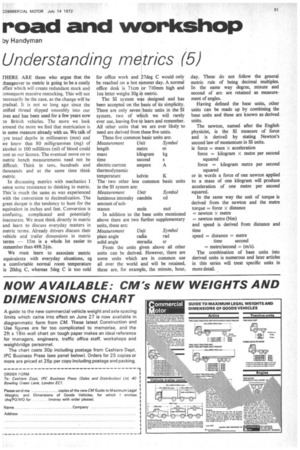road and workshop
Page 51

If you've noticed an error in this article please click here to report it so we can fix it.
by Handyman
Understanding metrics (5)
THERE ARE those who argue that the :hangeover to metric is going to be a costly iffair which will create redundant stock and ;onsequent massive restocking. This will not lecessarilv be the case, as the change will be ;radual. It is not so long ago since the mified thread slipped smoothly into our ives and has been used for a few years now Dn British vehicles. The more we look around the more we find that metrication is in some measure already with us. We talk of :yre tread depths in millimetres (mm) and we know that 80 milligrammes (mg) of alcohol in 100 millilitres (ml) of blood could cost us our licence. The eventual move on to metric bench measurements need not be difficult. Think in tens, -hundreds and thousands and at the same time think metric.
In discussing metrics with mechanics I sense some resistance to thinking in metric. This' is much the same as was experienced with the conversion to decimalization. The great danger is the tendency to hunt for the equivalent in inches and feet. Conversion is confusing, complicated and potentially inaccurate. We must think directly in metric and learn to discuss everyday matters in metric terms. Already drivers discuss their vehicle and trailer dimensions in metric terms 15m is a whole lot easier to remember than 49ft 2-fin.
We must learn to associate metric equivalents with everyday situations, eg a comfortable normal room temperature is 20deg C, whereas 5deg C is too cold for office work and 27deg C would only be reached on a hot summer day. A normal office desk is 71cm or 710mm high and I oz letter weighs 30g in metric.
The SI system was designed and has been accepted on the basis of its simplicity. There are only seven basic units in the SI system, two of which we will rarely ever use, leaving five to learn and remember. All other units that we are ever likely to need are derived from these five units.
These five common basic units are: Measurement Unit Symbol length metre rn mass kilogram kg time second electric current ampere A thermodynamic temperature kelvin The two other less common basic units in the SI system are: Measurement Unit Symbol luminous intensity candela cd amount of sub stance mole mol In addition to the base units mentioned above there are two further supplementary units, these are: Measurement Unit Symbol plain angle radia rad solid angle steradia sr From the units given above all other units can be derived. However, there are some units which are in common use all over the world and will be retained, these are, for example, the minute, hour, day. These do not follow the general metric rule of being decimal multiples. In the same way degree, minute and second of arc are retained as measurement of angles.
Having defined the base units, other units can be made up by combining the base units and these are known as derived units.
The newton, named after the English physicist, is the SI measure of force and is derived by stating Newton's second law of momentum in SI units. ie force = mass x acceleration force = kilogram X metre per second squared force = kilogram metre per second squared or in words a force of one newton applied to a mass of one kilogram will produce acceleration of one metre per second squared.
In the same way the unit of torque is derived from the newton and the metre torque = force x distance = newton x metre = newton metre (Nm) and speed is derived from distance and time speed = distance = metre time second = metre/second = (m/s).
The combination of base units into derived units is numerous and later articles in this series will treat specific units in more detail.






























































































